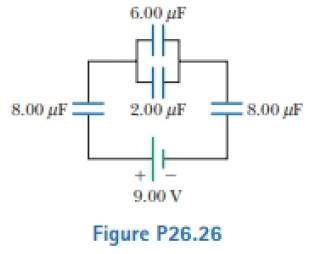
Concept explainers
Find (a) the equivalent capacitance of the capacitors in Figure P26.26, (b) the charge on each capacitor, and (c) the potential difference across each capacitor.

(a)
The equivalent capacitance of the capacitors.
Answer to Problem 26.26P
The equivalent capacitance of the capacitors in the system is
Explanation of Solution
Given: The figure given below shows the arrangement of capacitors.

Figure 1
Write the equation for equivalent capacitance in the series combination.
Here,
Substitute
Conclusion:
Therefore, the equivalent capacitance of the capacitors in the system is
(b)
The charge on each capacitor.
Answer to Problem 26.26P
The charge on
Explanation of Solution
Write the equation for charge on capacitor
Here,
Substitute
Thus, the charge on
The charge on
The charge on capacitor
Thus, the charge on
Write the equation for charge on capacitor
Here,
Substitute
Thus, the charge on
Write the equation for charge on capacitor
Here,
Substitute
The charge on
Conclusion:
Therefore, the charge on
(c)
The potential difference across each capacitor.
Answer to Problem 26.26P
The potential difference across all the capacitors are same and equal to
Explanation of Solution
Write the equation for potential difference across capacitor
Here,
Substitute
Thus, the potential difference across
The potential difference across
The potential difference across capacitor
Thus, the potential difference across
Write the equation for potential difference across capacitor
Here,
Substitute
Thus, the potential difference across
The potential difference across the
The potential difference across capacitor
The potential difference across
Conclusion:
Therefore, the potential difference across all the capacitors are same and equal to
Want to see more full solutions like this?
Chapter 26 Solutions
Physics for Scientists and Engineers, Technology Update (No access codes included)
 Physics for Scientists and Engineers: Foundations...PhysicsISBN:9781133939146Author:Katz, Debora M.Publisher:Cengage Learning
Physics for Scientists and Engineers: Foundations...PhysicsISBN:9781133939146Author:Katz, Debora M.Publisher:Cengage Learning Principles of Physics: A Calculus-Based TextPhysicsISBN:9781133104261Author:Raymond A. Serway, John W. JewettPublisher:Cengage Learning
Principles of Physics: A Calculus-Based TextPhysicsISBN:9781133104261Author:Raymond A. Serway, John W. JewettPublisher:Cengage Learning Physics for Scientists and Engineers, Technology ...PhysicsISBN:9781305116399Author:Raymond A. Serway, John W. JewettPublisher:Cengage Learning
Physics for Scientists and Engineers, Technology ...PhysicsISBN:9781305116399Author:Raymond A. Serway, John W. JewettPublisher:Cengage Learning Physics for Scientists and Engineers with Modern ...PhysicsISBN:9781337553292Author:Raymond A. Serway, John W. JewettPublisher:Cengage Learning
Physics for Scientists and Engineers with Modern ...PhysicsISBN:9781337553292Author:Raymond A. Serway, John W. JewettPublisher:Cengage Learning Physics for Scientists and EngineersPhysicsISBN:9781337553278Author:Raymond A. Serway, John W. JewettPublisher:Cengage Learning
Physics for Scientists and EngineersPhysicsISBN:9781337553278Author:Raymond A. Serway, John W. JewettPublisher:Cengage Learning College PhysicsPhysicsISBN:9781285737027Author:Raymond A. Serway, Chris VuillePublisher:Cengage Learning
College PhysicsPhysicsISBN:9781285737027Author:Raymond A. Serway, Chris VuillePublisher:Cengage Learning





